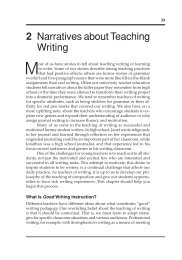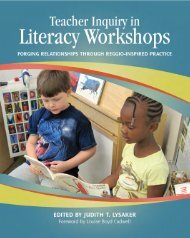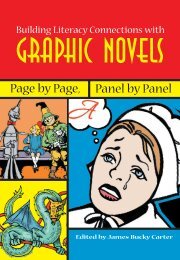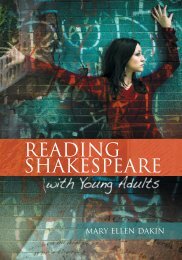Wood_cover.qxd (Page 1) - National Council of Teachers of English
Wood_cover.qxd (Page 1) - National Council of Teachers of English
Wood_cover.qxd (Page 1) - National Council of Teachers of English
- No tags were found...
Create successful ePaper yourself
Turn your PDF publications into a flip-book with our unique Google optimized e-Paper software.
70 Chapter 4erated quiz, readers’ theater, and reflective writing are used to accomplishthis goal. Readers’ theater is a strategy <strong>of</strong>ten used to show studentshow to give voice to a text and to engage reluctant readers. It usuallyinvolves a group reading from a text without memorizing it or usingprops. For this speech, it is important that students have a good understanding<strong>of</strong> the text before asking them to read it aloud.Start by playing the recording that has Dr. King’s own voice deliveringthe speech in Washington while students read along. Allowingstudents to hear Dr. King’s speech given live not only puts the speechinto context, but it gives students a chance to hear the way it originallysounded. Ask students to focus on the way Dr. King uses his voice toevoke emotion and place emphasis on specific words. After listeningto the speech, allow the class to ask clarifying questions to make surethey understand who King’s audience was and what his purpose wasin writing such an unforgettable speech. Also, give students a few minutesto underline words that they do not know or phrases such as“Emancipation Proclamation” that have to do with history. (Note: Therecording <strong>of</strong> “I Have a Dream” can be found at many public libraries,and the written copy <strong>of</strong> the speech can be located at the followingwebsite: http://www.americanrhetoric.com/speeches/Ihaveadream.htm.)Give each student the organizer in Figure 4.1 to record the wordsand phrases they underlined. Students will then research their wordsand phrases in order to complete the organizer. It is important to talkto students about the difference between the meaning <strong>of</strong> a word orphrase and the way it is used in the context <strong>of</strong> Dr. King’s speech. This isan opportunity to talk about the denotations and connotations <strong>of</strong> words.Once students have a better understanding <strong>of</strong> what their sections <strong>of</strong> thespeech mean, they should be able to do two things: write paragraphsexplaining their sections <strong>of</strong> the speech and formulate quiz questions thatwill test the knowledge <strong>of</strong> the rest <strong>of</strong> the class. Allow students to shareand discuss their questions with the whole class so that students willhave a chance to ask questions and take notes before being quizzed ontheir understanding <strong>of</strong> the speech.Classroom Snapshot: Below are some example quiz questions that mystudents wrote. My class recorded their questions on a piece <strong>of</strong>butcher paper that had been divided into two columns, one for questionsand one for answers. Every day that we worked on the speech,I gave students a few minutes at the beginning <strong>of</strong> class to write answerson the wall. This was our way <strong>of</strong> reviewing for the quiz that
















